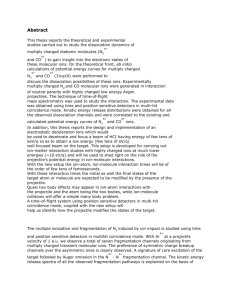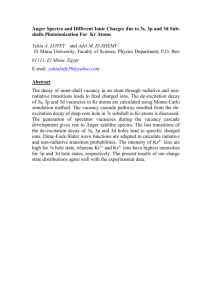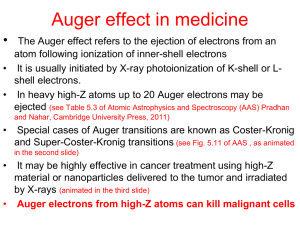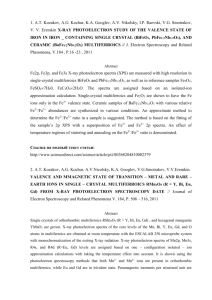EPAPS (ExpCom - AIP FTP Server
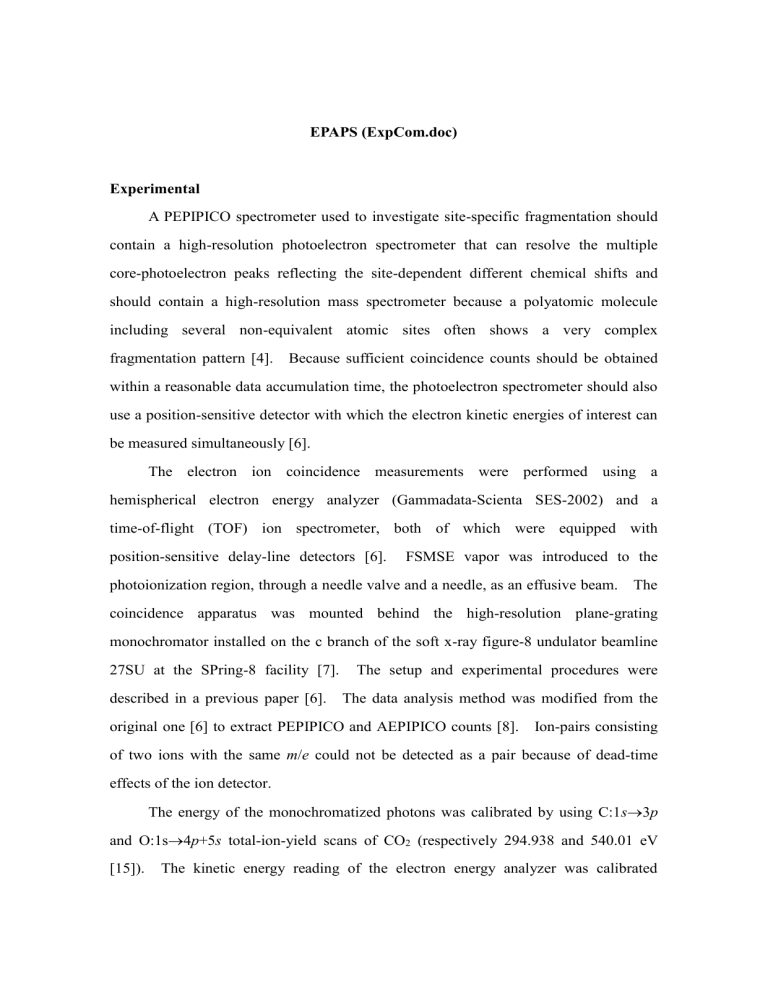
EPAPS (ExpCom.doc)
Experimental
A PEPIPICO spectrometer used to investigate site-specific fragmentation should contain a high-resolution photoelectron spectrometer that can resolve the multiple core-photoelectron peaks reflecting the site-dependent different chemical shifts and should contain a high-resolution mass spectrometer because a polyatomic molecule including several non-equivalent atomic sites often shows a very complex fragmentation pattern [4]. Because sufficient coincidence counts should be obtained within a reasonable data accumulation time, the photoelectron spectrometer should also use a position-sensitive detector with which the electron kinetic energies of interest can be measured simultaneously [6].
The electron ion coincidence measurements were performed using a hemispherical electron energy analyzer (Gammadata-Scienta SES-2002) and a time-of-flight (TOF) ion spectrometer, both of which were equipped with position-sensitive delay-line detectors [6]. FSMSE vapor was introduced to the photoionization region, through a needle valve and a needle, as an effusive beam. The coincidence apparatus was mounted behind the high-resolution plane-grating monochromator installed on the c branch of the soft x-ray figure-8 undulator beamline
27SU at the SPring-8 facility [7]. The setup and experimental procedures were described in a previous paper [6]. The data analysis method was modified from the original one [6] to extract PEPIPICO and AEPIPICO counts [8]. Ion-pairs consisting of two ions with the same m / e could not be detected as a pair because of dead-time effects of the ion detector.
The energy of the monochromatized photons was calibrated by using C:1 s
3 p and O:1s
4 p +5 s total-ion-yield scans of CO
2
(respectively 294.938 and 540.01 eV
[15]). The kinetic energy reading of the electron energy analyzer was calibrated
against the kinetic energies of Ar: L
3
M
23
M
23
-
1
S
0
, L
3
M
23
M
23
-
1
D
2
,
L
3
M
23
M
23
-
3
P
0,1,2
+ L
2
M
23
M
23
-
1
D
2
, and L
2
M
23
M
23
-
3
P
0,1,2
normal Auger peaks (respectively
201.09, 203.47, 205.42, and 207.23 eV [16]) and against the binding energy of the
Ar:2 p
3/2
photoelectron peak (248.45 eV [16]). The possible errors inherent in this calibration (
0.1 eV) would simply shift the energy scale, preserving the relative relations of the energies. The sensitivity dependence on the electron-detection position in the delay-line detector was calibrated by sweeping the Ar:2 p
3/2
photoelectron peak across the detector at a constant speed.
The resolution of the electron energy analyzer (
E e
) was determined from a line-width measurement of Xe:4 d photoelectron peaks (binding energies = 67.5 and
69.5 eV [16]). Since the inherent lifetime widths of Xe:4 d
-1
states are small enough to be ignored [17], the full width at half maximum (FWHM) of the peak is given by {
E e
2
+ D 2 +
E p
2 } 1/2 , where
E p
is the FWHM of the optical resolution and D is the Doppler broadening given (in meV) by 0.7215( E k
T/m )
1/2
[18], where E k
, T , and m are respectively the electron kinetic energy in eV, the absolute temperature, and the atomic mass of Xe (131.3 amu).
The high resolving power of the electron-energy-analyzing system was maintained by applying no static electric field across the ionization region. After photoionization of a sample molecule (FSMSE), an electron entered the electron analyzer and triggered a rectangular high-voltage pulse. This pulsed electric field was applied across the ionization region, projecting the ions toward the ion detector.
Considering these experimental conditions, we calculated that H
+
ions with kinetic energies > 2.5 eV would escape from the ionization region before the pulsed electric-field was applied and would not be detected. Accordingly, in this paper we do not discuss the site dependence of the yield and kinetic energy of the H
+
ions [4].
The counts in Fig. 1 were measured at a photon energy of 400.5 eV. The monochromator slit width ( E /
E ) was 4000 and the resolution of the electron energy
analyzer was 1.3 eV. The data collection time was 6598 s.
The counts in Fig. 2 were measured at a photon energy of 400.5 eV. Because of the limited statistics, the original kinetic-energy data-points were reduced by summation over the counts of 10 neighboring data points. The data collection time was 70087 s.
Error bars are ±one-sigma.
The counts in Fig. 3 were measured at a photon energy of 260.4 eV. The original kinetic-energy data-points were reduced in (a), (d), and (e) by summation over the counts of 3 neighboring data points, in (b) and (c) by summation over the counts of
10 neighboring data points, and in (f) and (g) by summation over the counts of 25 neighboring data points. The data collection times were 43674 s in (a)–(e) and 72941 s in (f)–(g). Error bars are ±one-sigma.
This study was performed with the approval of JASRI.
Computational method and procedure
The computational method and procedure used in the present ab initio MO calculations of the Si: LVV normal Auger transition probability of FSMSE have been described in detail in a previous paper [9]. The Gaussian 98 program [19] was used for geometry optimization, without any symmetry constraints, at the MP2/cc-pVDZ level. MOs for the ground and core-hole states were produced within the density functional theory framework by StoBe-deMon code using III-IGLO basis for the core-ionized Si atom, (311/211/1) basis with effective core potential (ECP) for the other heavy atoms, and (311/1) basis for H [20]. A core-hole MO was produced for each of the Si:2 p x
, Si:2 p y
, and Si:2 p z
core holes, so a total of three sets of core-hole MOs were prepared. Note that the wave function of a Si: LVV normal Auger final-state describes the behavior of ( N -2) electrons giving singlet or triplet spin-multiplicity because the
Auger initial-state with ( N -1) electrons is a doublet. Here N denotes the number of electrons in the calculation for the ground state. Limited spin-symmetry-adapted
configuration-interaction (CI) calculations within the two-hole valence space were used to determine the wave functions of the Auger final-states. The Auger transition probability was estimated from the atomic populations of two valence orbitals on a core-ionized Si atom while neglecting the term associated with the Auger-electron.
Löwdin's population was then adopted. The computational Auger-photoelectron coincidence spectrum (APECS) of FSMSE will be reported elsewhere [13].
Molecular motions immediately after emission of the Si:2 p photoelectrons of
FSMSE were predicted by using molecular dynamics (MD) simulations [21]. The MD simulation was started from the Si:2 p core-ionized nonvibrating molecule in the ground-state equilibrium geometry at 0 K. The Verlet algorithm was used as an integrator of the equations of motion, and the time step was 1 fs. The simulations were run for 30 fs, which is sufficiently long for our objective because the short lifetime of the Si:2 p core hole (1–10 fs) ensures refilling of most core holes within this period.
Comparison with fragmentation in the condensed phase
The site-specific fragments formed by the Si:2 p photoionization of FSMSE in the vapor phase are very different from those formed in the condensed phase, where H
+
and
F
+
ions are desorbed in coincidence with the emission of the Si[Me]:2 p and Si[F]:2 p photoelectrons [11]. A possible reason for this was suggested by Tinone et al.
[22].
In the condensed phase, the heavy ions such as SiF
+
, Si(CH
3
)
2
+
, SiF
2
+
, Si(CH
3
)
3
+
, SiF
3
+
, and F
3
SiCH
2
CH
2
+
are, owing to their relatively slow movement, reneutralized or recaptured effectively by the surface, and only H
+
and F
+
are desorbed site-specifically.
We do not discuss here the site-specificity of H
+
formed in the vapor phase because energetic H
+
ions have, as described above, escaped from the ionization region before they could be detected.
Asymmetry in site-specific fragmentation
The site-specific fragmentation pattern is more clearly seen in the diagram showing the corresponding asymmetry. asymmetry = ( a − b )/( a + b ), a = A / AN , b = B / BN (4)
A and B are respectively the numbers of (mass selected) ions (or ion-pairs) detected in coincidence with the Si[F]:2 p and Si[Me]:2 p photoelectrons, and AN and BN are respectively the numbers of Si[F]:2 p and Si[Me]:2 p photoelectrons. This definition ensures that if the Si[F]:2 p and Si[Me]:2 p core-ionized states lead to the same pattern of fragmentation, the asymmetry of all ionic fragments (or ion-pairs) is zero. The asymmetry in site-specific fragmentation of FSMSE is given in this EPAPS document.
References
[15] K. C. Prince et al.
, J. Phys. B 32 , 2551 (1999).
[16] K. Siegbahn et al ., ESCA Applied to Free Molecules (North-Holland, Amsterdam,
1969), pp. 36–41 and 156–163.
[17] M. Jurvansuu, A. Kivimäki, and S. Aksela, Phys. Rev. A 64 , 012502 (2001).
[18] P. Baltzer, L. Karlsson, M. Lundqvist, and B. Wannberg, Rev. Sci. Instrum. 64 ,
2179 (1993).
[19] M. J. Frisch et al ., Gaussian 98 , Revision A.4 (Gaussian, Inc, Pittsburgh, PA,
1998).
[20] K. Hermann and L. G. M. Pettersson et al ., StoBe-deMon Version 1.0 (StoBe
Software, 2002).
[21] B. Brena et al ., Phys. Rev. Lett. 93 , 148302 (2004).
[22] M. C. K. Tinone et al ., J. Chem. Phys. 100 , 5988 (1994).
